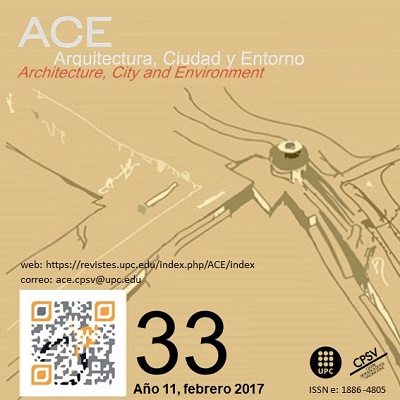Modelat 3D del Patrimoni Cultural i visualització dins d'un entorn de Realitat Augmentada, basat en Tecnologies d'Informació Geogràfica i plataformes mòbils
DOI:
https://doi.org/10.5821/ace.11.33.4686Paraules clau:
Representacions digitals, SIG, RA, Lisboa, aqüeducteResum
Aquest article s'aplica les Tecnologies de la Informació Geogràfica (TIG) al camp del Patrimoni Cultural (PC), amb l'objectiu d'analitzar la valoració patrimonial a través de les Representacions Digitals (RD). Busca introduir breument la importància de la RD a través dels conceptes de percepció espacial (mental) i percepcions físiques (externes) de l'individu. Aborda els principals temes d'adquisició de dades 3D, modelat i visualització, així com aplicacions de patrimoni cultural, i presenta assajos 3D i Realitat Augmentada (RA), juntament amb els seus principals resultats i discussió. La metodologia consisteix en l'adquisició exploratòria de dades mitjançant vehicles aeris terrestres i no tripulats (UAV), els procediments de modelatge 3D i la integració entre sistemes d'informació geogràfica 3D (SIG) i ambients RA (plataformes mòbils) aplicats a sistemes patrimonials i elements urbans.
Els resultats consisteixen en diversos assajos i productes d'adquisició 3D i processos de modelatge per a ser visualitzats en un entorn RA. Aquests permeten ajustar les solucions principals per a un major desenvolupament d'aplicacions mòbils. Prenent com a exemple l'antic sistema d'abastament d'aigua de Lisboa, Portugal (Aqüeducte) (classificat com a monument nacional), el fet que la major part és imperceptible, a causa de la gran extensió de les galeries subterrànies, permet la visualització in situ de la relació entre I els elements de la ciutat dins d'un entorn de realitat mixta. Els mètodes utilitzats apunten a reforçar la idea de la potencial aplicació d'aquesta tecnologia per a la valoració patrimonial, associant l'ús de la informació geogràfica a camps comunament relacionats amb una forta percepció visual de l'espai, proporcionant dades essencials no només per a usuaris ocasionals També per a tècnics especialitzats, persones que prenen decisions, promotors i altres parts interessades.
Descàrregues
Publicades
Número
Secció
Llicència
| CRITERIS DE PROTECCIÓ INTEL·LECTUAL |
En aquest moment es compta amb la protecció de la Oficina Espanyola de Patents i Marques, mentre que la protecció global s'està tramitant davant la Organització Mundial de la Propietat Intel·lectual (OMPI/WIPO). Així mateix, la Oficina del Número de Sèrie Estàndar Internacional (ISSN) ha otorgat els següents números: 1886-4805 (versió electrònica) i 1887-7052 (versió en paper). |
| COPYRIGHT |
El contingut dels articles i els comentaris en ells expresats són responsabilitat exclusiva dels seus actors, i no reflexen necessariament la opinió del Comité Editor de la revista. Els treballs publicats per ACE queden sotmesos a la llicència CC BY-NC-ND 3.0 ES http://creativecommons.org/licenses/by-nc-nd/3.0/es/ La qual cosa vol dir que les persones autores només tenen i retenen els drets d'autor dintre de les limitacions imposades per la anterior llicència |





































